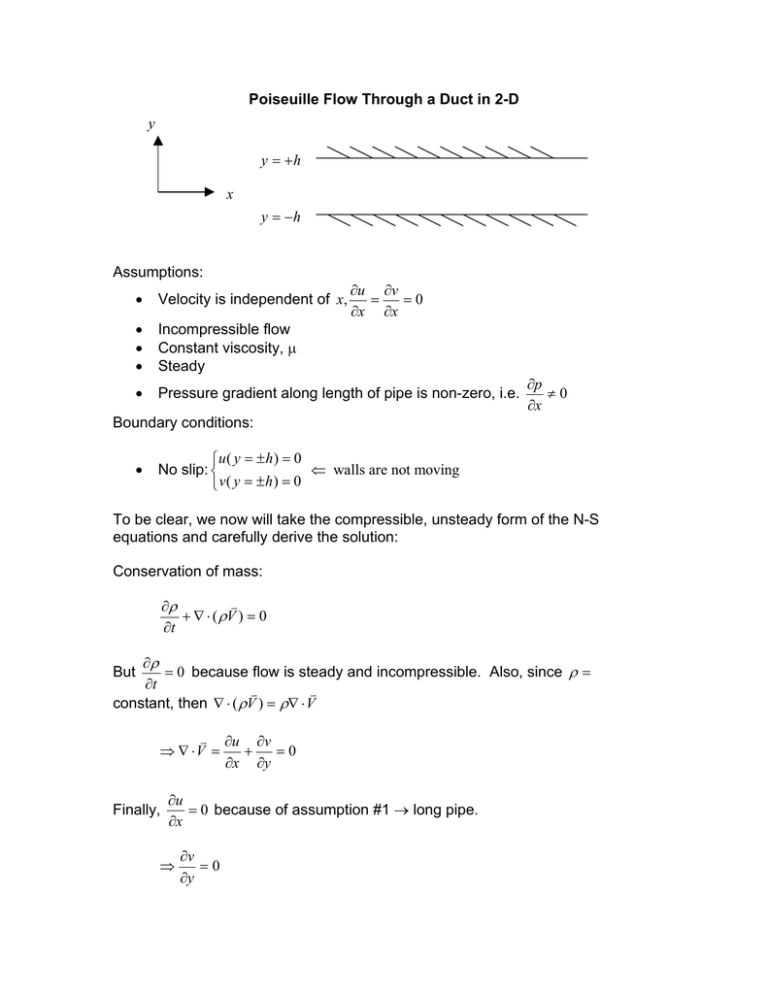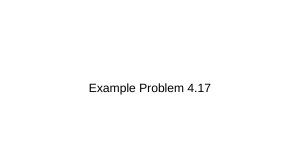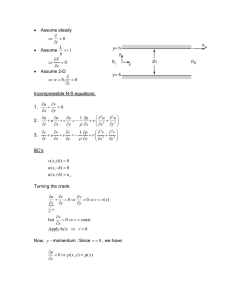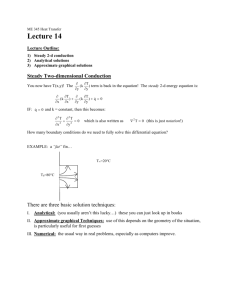Poiseuille Flow Through a Duct in 2-D Assumptions: ∂
advertisement

Poiseuille Flow Through a Duct in 2-D y y = +h x y = −h Assumptions: ∂u ∂v = =0 ∂x ∂x • Velocity is independent of x, • • • Incompressible flow Constant viscosity, µ Steady • Pressure gradient along length of pipe is non-zero, i.e. ∂p ≠0 ∂x Boundary conditions: • u ( y = ± h ) = 0 No slip: ⇐ walls are not moving v( y = ±h) = 0 To be clear, we now will take the compressible, unsteady form of the N-S equations and carefully derive the solution: Conservation of mass: ∂ρ + ∇ ⋅ ( ρV ) = 0 ∂t ∂ρ = 0 because flow is steady and incompressible. Also, since ρ = ∂t constant, then ∇ ⋅ ( ρV ) = ρ∇ ⋅ V But ⇒ ∇ ⋅V = Finally, ∂u ∂v + =0 ∂x ∂y ∂u = 0 because of assumption #1 → long pipe. ∂x ⇒ ∂v =0 ∂y Poiseuille Flow Through a Duct in 2-D Now, integrate this: v = constant = C Apply boundary conditions: v ( ± h ) = 0 ⇒ v ( y ) = 0 We expect this but it is good to see the math confirm it. Now, let’s look at y − momentum . Conservation of y − momentum : ∂τ ∂p ∂τ Dv = − + xy + yy ∂y ∂x ∂y Dt ∂τ ∂v ∂p ∂τ ρ + V ⋅ ∇v = − + xy + yy ∂t ∂y ∂x ∂y ρ ∂τ ∂v ∂v ∂p ∂τ ∂v = − + xy + yy +u +v ∂t ∂y ∂x ∂y ∂x =0 ∂y ρ =0 steady =0 Now, what about τ xy &τ yy τ xy ∂u ∂u ∂v → τ xy = µ = µ + ∂y ∂y ∂x =0 τ yy = 2 µ ∂v +λ ∂y v =0 ∂u ∂v ∂x + ∂y → τ yy = 0 ∇ iV =0 So y − momentum becomes: 0=− But ∂p ∂ ∂u µ + ∂y ∂x ∂y ∂u ∂ ∂u µ = 0 because = 0 & µ = constant ∂x ∂y ∂x 16.100 2002 2 Poiseuille Flow Through a Duct in 2-D ⇒ 0=− ∂p ⇒ p ( x, y , t ) = p ( x ) ∂y ∂p ∂t =0 (steady) Conservation of x − momentum : ρ ∂τ Du dp ∂τ =− + xx + yx Dt dx ∂x ∂y p= p( x ) only ∂u ∂u ∂u ∂u ∂ ∂u dp ∂ +u =− + ρ +v 2µ µ + ∂t ∂x =0 ∂y ∂x ∂y ∂y dx ∂x =0 =0 =0 steady 0=− dp ∂ ∂u µ + dx ∂y ∂y Now, we just need to solve this… ∂ ∂u dp µ = ∂y ∂y dx µ = const & u = u ( y ) so, d 2u 1 dp = ⇒ must be constant 2 µ dx dy only f ( y ) ⇒ only f ( x ) dp = const. ⇒ pressure can only be a linear function of x ! dx Now, integrating twice in y gives: u( y ) = 1 dp 2 y + C1 y + C0 2 µ dx Finally, apply BC’s: 16.100 2002 3 Poiseuille Flow Through a Duct in 2-D u( ± h ) = 0 1 u( + h ) = 2µ 1 u( −h ) = 2µ dp 2 h + C1h + C0 = 0 dx dp 2 h − C1h + C0 = 0 dx Solve for C0 & C1 gives: C0 = − 1 dp 2 h 2 µ dx C1 = 0 ⇒ 2 −1 dp y u( y ) = 1 − 2 µ h 2 dx h 16.100 2002 4







